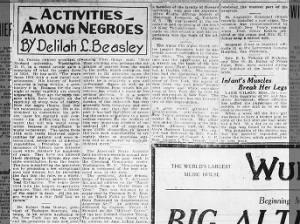Activities Among Negroes
Dr. Durkee 1 2 (white) president of Howard university, Washington, D. C., in a recent article gave a summary of what the negro faces in 1924. He has said: "The negro faces 1924 with a new racial consciousness. His history of buried centuries is being written, a great history it is. Reasons for the long night of racial captivity are clearly appearing. They are the same reasons which have brought on the captivity of every race of history. Now the negro thanks God that his renaissance appears. He is determined to consolidate his powers, mass his strength and overcome his difficulties by racial worth that will win world recognition because it contributes to world betterment. The negro faces 1924 with vastly improved opportunities for national and even international, revelations of inherent capabilities. Prejudice and ignorance of history have fettered most white thinkers for hundreds of years. They have not allowed their thinking to include any possible contribution from the negro. The race is shattering the ignorance not by producing a few exceptional men and women, but by revealing the fact that the race, as a whole, has those inherent powers which feed civilization. The negro faces 1924 with the largest co-operative agencies. That old phrase 'a friend of the negro' is dead. All the negro wants is a fair field and no favors."
Dr. Robert Russ Morton, 3 4 principal of Tuskegee Institute, Alabama, in an article appearing in the New York Age on the negro and his prospects in this new year, among other things, said: "More than anything else perhaps the migration of negroes from the south to the north, which continues, has served to fix attention upon the negro in those parts of the country where he is relatively a new and unfamiliar figure as well as in those sections from which his departure has created a more or less serious problem. It is a source of satisfaction to note that the discussion of this migration has very generally been temperate and considerate, and that, for the most part it has had the effect of arousing the nation as a whole to a more serious concern for the welfare of this very important element of our national life, and of creating a more active disposition to accord the race such opportunities as are rightly theirs as American citizens and as measured by their individual merit."
The American Negro Academy 5 6 held its twenty-seventh annual conference during the past week in the Cleveland Community center, Washington, D. C. This organization is composed of the best educated men of the race.
The president, Arthur Schomberge, [Schomburg] of Brooklyn, N. Y., delivered his annual address on the "Racial Outlook From a World Point of View." This was followed by a paper read by Freeman H. M. Murry [Murray] on "Black Folks as They Have Been Portrayed in Representative American Art." An address was delivered by Captain Frank R. Steward on the "Military Career" of the late Colonel Charles Young.
The conference was closed with an address by Alan LeRoy Locke, a member of the faculty of Howard university, who was the representative of the African Society of Historical Research of Yonkers, N. Y. He was present at the excavation and reopening of the tomb of King Tutankhamen. His notes made on this occasion and his experiences was the basis of his address.
The Alpha Phi Alpha Greek letter (negro) fraternity held its sixteenth annual convention in Columbus, Ohio. The outstanding feature was the pilgrimage to place a wreath on the tomb of the late negro poet, Paul Lawrence Dumbar, [Paul Laurence Dunbar] in Dayton, Ohio. The convention had the distinction of receiving an invitation from the governor of New York, the mayor of New York city and many prominent negro and white organizations of New York City to hold its next convention in New York. The state of California has two fraternities of this organization.
A large crowd attended the Emancipation celebration held New Year's evening in Taylor Memorial M. E. church. The affair was under the auspices of the Ministerial Alliance and the Negro Men's Business League. The oration was delivered by Rev. W.R. Lovell, pastor of Cooper A.M.E. Zion church. The Temple band rendered the musical part of the program.
St. Augustine Episcopal church recently installed a new organ. The occasion was commemorated by a recital New Year's morning, when Prof. Elmer Keaton presided at the organ and Mrs. H. C. Johns sang a sacred solo.
Sergeant Jones is reported critically ill at the Letterman General Hospital, San Francisco.
Rev. S. L. Tillman of Berkeley and Miss D. M, Butler of Friers Point, Miss., were married during the holidays at the home of the bride.
1 "J. Stanley Durkee". Embryo Project Encyclopedia (1925). ISSN: 1940-5030 http://embryo.asu.edu/handle/10776/2774.
2 Durkee, J. Stanley (James Stanley), 1866-1951 http://n2t.net/ark:/99166/w61r7cfr
3 James Weldon Johnson (right) and Robert R. Morton (left) at the funeral of Progressive mayor Seth Low in 1916. Johnson (1871-1938), was a Harlem Renaissance poet, author, educator, and civil rights activist. Robert R. Morton was the principal of Tuskegee Institute. - Image ID: BTKBEF https://www.alamy.com/stock-photo-james-weldon-johnson-right-and-robert-r-morton-left-at-the-funeral-32388231.html
4 Robert R. Morton letter to President Woodrow Wilson, July 7, 1917 https://ohiomemory.org/digital/collection/p15005coll34/id/473/
5 AMERICAN NEGRO ACADEMY (1897-1924) https://www.blackpast.org/african-american-history/american-negro-academy-1897-1924/
6 American Negro Academy https://en.wikipedia.org/wiki/American_Negro_Academy




